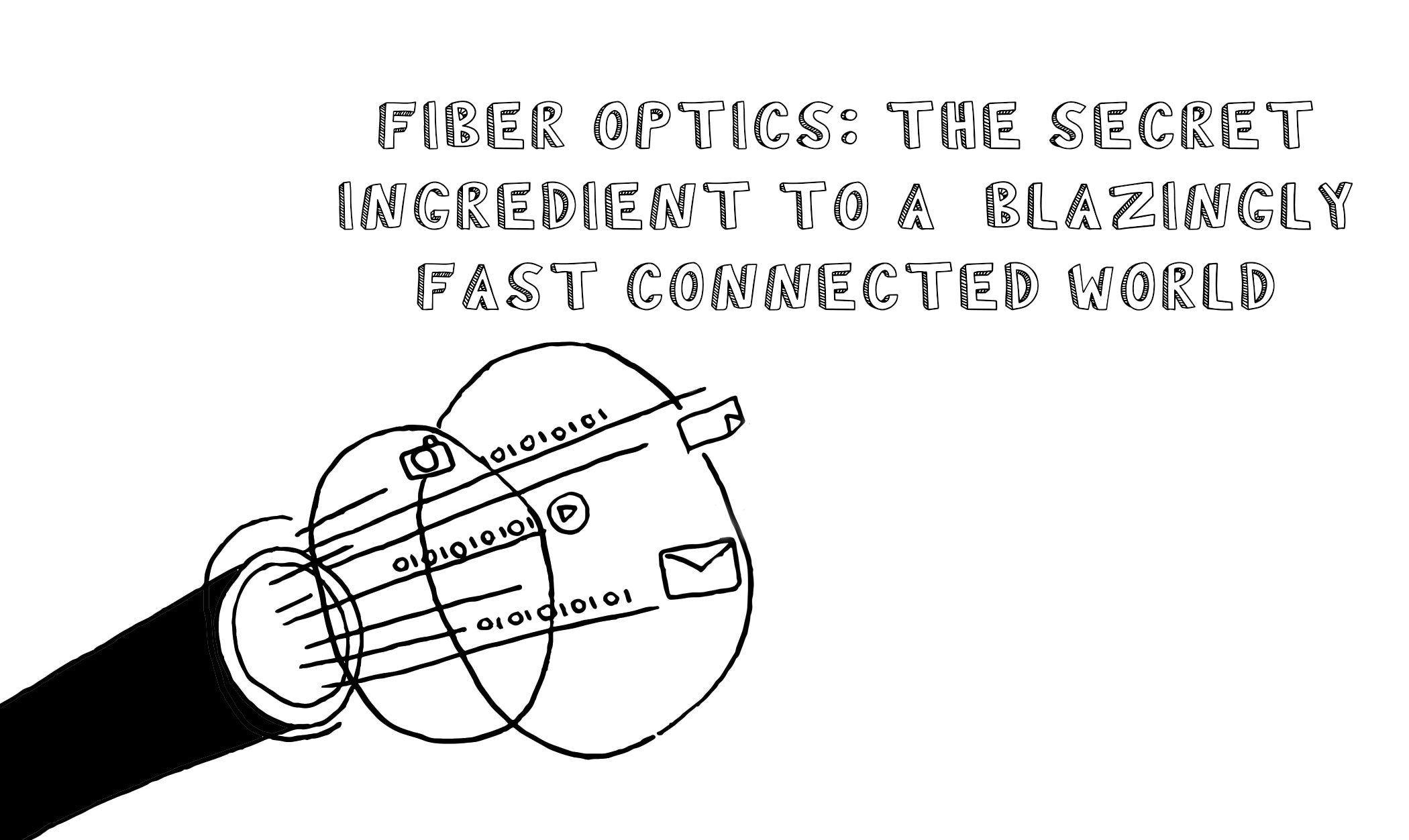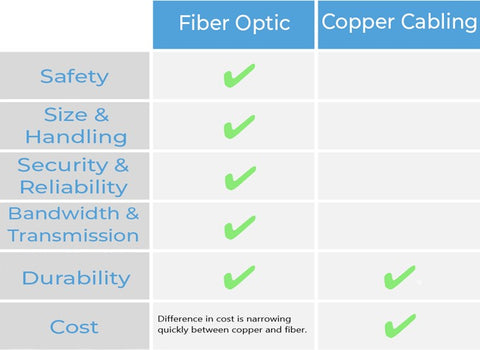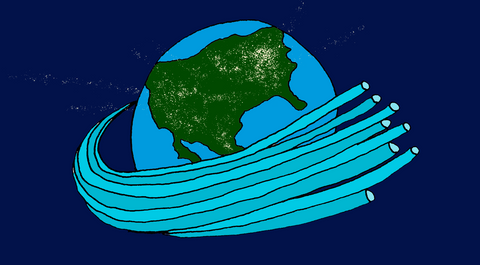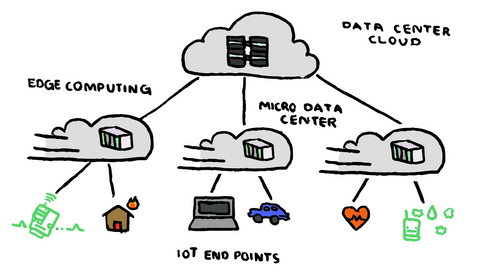Payment methods accepted

Fiber Optics: The Secret Ingredient to a Blazingly Fast Connected World!
Written by Ben Hamlitsch, trueCABLE Technical and Product Innovation Manager RCDD, FOI
Connecting and powering devices at the network's periphery—from Wi-Fi access points and security cameras to LED lighting and digital displays—has traditionally relied on twisted-pair copper cable as part of the horizontal LAN infrastructure. Fiber optic cabling's importance in today's fast-paced digital world cannot be overstated. It is now the de facto standard for LAN backbone infrastructure and data center connectivity. However, this doesn't stop fiber from expanding horizontally and eventually becoming the backbone of the global internet, a task that is becoming easier than ever before.
To begin, during the past two decades, the price of optical transceivers has dropped dramatically. Fiber deployment costs are decreasing but remain higher than copper's active equipment costs. Fiber optic cable now costs about the same as copper, and advances in pre-terminated fiber cables as well as MTP/MPO cables and field termination solutions have made fiber installation simpler than ever. In addition to being more resilient and able to bear more pulling force and pressure than copper, fiber is impervious to electromagnetic and radio-frequency interference (EMI/RFI) and the corrosive effects of temperature fluctuations and weather. Fiber optic cable is also more eco-friendly since it uses less rack, roadway, and inventory space due to its diminutive size and low weight. But its bandwidth and reach are the true reasons it's becoming the standard.
Why will Fiber Optics beat out Copper?
Fiber optic cable is a necessary component of modern networks because of the exponential growth in data generated by more endpoints. The quantity of data that must be sent over networks has increased by a factor of 10 as the number of connected devices owned by the average user has increased from eight to twelve. By 2025, it is predicted that there will be 75 billion IoT devices in use, creating daily data traffic of 463 exabytes (EB). To give you an idea of how much space it takes up, 1 EB is equal to 1 billion GB.
While the quantity of data over a corporate LAN (local area network) is in large part determined by the nature of the company, most modern businesses are upgrading to backbone speeds in excess of 10 GB/s. Companies in the financial, healthcare, technology, entertainment/media, retail, insurance, and educational sectors, which generate the most data, are adopting backbone LAN speeds of up to 100 GB/s.
Consider that the maximum throughput for Wi-Fi 6 access points (WAPs) servicing users on a single floor of a typical business building is only achievable with a backbone capable of at least 25 GB/s. Fiber is the sole option for transporting user data to the data center, as copper twisted-pair cabling's maximum data transfer rate is just 10 GB/s. More bandwidth is required to send information from the data center's many floors, users, and devices to the internet. About a million gigabytes of data pass through Facebook's data centers every day, yet they still can't compete with Amazon. In addition to being more sustainable, fiber's infinite bandwidth capacity also means it has a longer lifespan to support generation after generation of network enhancements.

Will Fiber Optics Link the World?
Fiber not only allows for more bandwidth but also has a far greater range than copper for transmitting data. Wave division multiplexing (WDM) allows for the transmission of up to 400 GB/s of data over a distance of 40 kilometers over a single strand of singlemode fiber. IEEE (802.3cw) is currently developing singlemode dense WDM applications that can carry 400 GB/s over distances of up to 80 kilometers (approximately 50 miles).
Fiber is the obvious medium for interconnecting structures, neighborhoods, cities, and even continents. Did you know that the fiber optic cables that stretch across the Atlantic Ocean from Virginia Beach to Balboa, Spain, weigh more than 10 million pounds, consist of millions of individual strands, and have the capacity to transmit 4 million high-definition (HD) movies in a single direction? This is only one of several transoceanic connections depicted on the submarine cable map.
Because of the growing number of edge devices (Wi-Fi access points, surveillance cameras, access control systems, etc.) that need to connect in far-flung places as well as enormous buildings like parking garages, warehouses, arenas, and convention centers, copper is also being deployed in the horizontal LAN.

What is an Edge Data Center?
An edge data center is a type of data center that is located closer to the end-users or devices that are generating or consuming data. This is in contrast to traditional data centers, which are typically located in centralized locations and serve a wide range of users and applications.
Edge data centers are designed to provide low-latency, high-bandwidth connectivity to nearby users and devices, which is essential for applications that require real-time data processing and analysis, such as autonomous vehicles, IoT devices, and mobile applications. By bringing data processing and storage closer to the edge of the network, edge data centers can reduce the amount of data that needs to be transmitted to centralized data centers, which can help reduce network congestion and improve overall network performance.
Edge data centers are typically smaller in size than traditional data centers, and they are often located in facilities such as cell towers, remote offices, and other edge locations. They are also designed to be more modular and scalable than traditional data centers, which allows them to be deployed quickly and easily in a variety of different locations.
Despite fiber's obvious centrality in LAN backbone connections, data center interconnections, and global connectivity, it's also creeping closer to the periphery, especially in several crucial vertical sectors.
In order to transfer more data at higher speeds, financial institutions are laying horizontal fiber optic cables wider and farther apart. For instance, in high-frequency trading, the speed of the data is important in order to make stock trades in a fraction of a second. Fiber is essential for interconnecting stock exchanges, and it is already making its way onto trading floors to link high-performance trading clusters. That's because milliseconds are worth millions in high-frequency trading.
Health care—Timely access to patient records can literally be a matter of life and death in hospitals and other healthcare organizations. Digital medical photos can be as large as 300 MB in size, and there might be up to 30 photographs in a single patient's file. In order to get the patient file in a little over seven seconds, you need a download speed of at least 10 Gb/s. While that may appear fast at first glance, a hospital network is really rather busy due to the large number of applications it supports (from patient monitoring and security to nurse calls and entertainment). However, with a 40 Gb/s fiber link, the same picture may be presented to a surgeon in under two seconds.

Why is Fiber better than Copper?
Data transmission on copper is disrupted by electromagnetic and radio-frequency interference (EMI/RFI), but fiber optic cables are unaffected. As a result, fiber connections are being made between vital pieces of medical equipment at the network's periphery.
Fiber is significantly more secure than copper or coaxial cable for government, military, and top-secret applications since no electromagnetic leakage occurs and it is exceedingly difficult to extract communications. Because of this, it is often used in settings where top-secret information must be safeguarded, such as the government, the military, and top-secret R&D labs. An alarm system that uses fiber is possible. Since it is likewise unaffected by illumination, it may be utilized as a perimeter fence and subjected to constant monitoring to detect any intrusions.
As more devices are connected to support everything from high-definition video streaming and online gaming to virtual and augmented reality and emerging IoT and 5G technologies like advanced data analytics and machine learning, it's true that some vertical markets are deploying more fiber in the horizontal infrastructure than others. More and more sites are installing purpose-built, high-density edge data centers to handle this data locally for an immediate reaction rather than sending it back to the cloud. Any area where a large amount of data is gathered and processed is considered an on-premises location. This includes industrial and manufacturing facilities, regional 5G macro-cellular sites, and even a municipal street corner for processing smart traffic information. As edge data centers continue to proliferate, fiber optic cables are being laid to bring them closer to end users and their devices.
As data requirements continue to increase and system demand grows, fiber optics will not only dominate backbone cabling but soon become the go-to cabling infrastructure for horizontal and workstation applications. Fiber Optics is the future, and trueCABLE will be there every step of the way.
HAPPY NETWORKING!
trueCABLE presents the information on our website, including the “Cable Academy” blog and live chat support, as a service to our customers and other visitors to our website subject to our website terms and conditions. While the information on this website is about data networking and electrical issues, it is not professional advice and any reliance on such material is at your own risk.



























